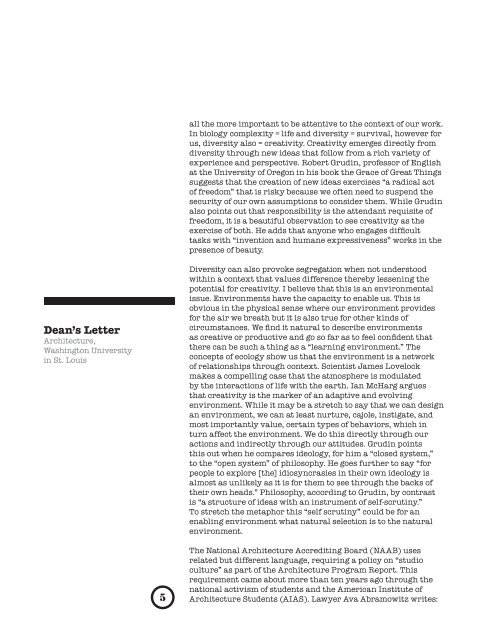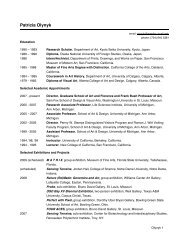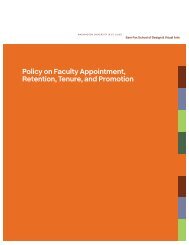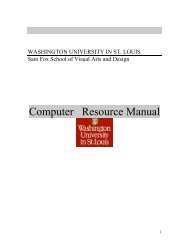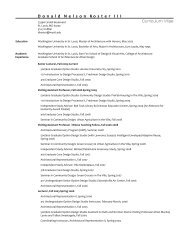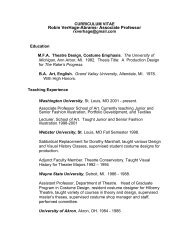architecture - Sam Fox School - Washington University in St. Louis
architecture - Sam Fox School - Washington University in St. Louis
architecture - Sam Fox School - Washington University in St. Louis
Create successful ePaper yourself
Turn your PDF publications into a flip-book with our unique Google optimized e-Paper software.
Dean’s Letter<br />
Architecture,<br />
<strong>Wash<strong>in</strong>gton</strong> <strong>University</strong><br />
<strong>in</strong> <strong>St</strong>. <strong>Louis</strong><br />
5<br />
all the more important to be attentive to the context of our work.<br />
In biology complexity = life and diversity = survival, however for<br />
us, diversity also = creativity. Creativity emerges directly from<br />
diversity through new ideas that follow from a rich variety of<br />
experience and perspective. Robert Grud<strong>in</strong>, professor of English<br />
at the <strong>University</strong> of Oregon <strong>in</strong> his book the Grace of Great Th<strong>in</strong>gs<br />
suggests that the creation of new ideas exercises “a radical act<br />
of freedom” that is risky because we often need to suspend the<br />
security of our own assumptions to consider them. While Grud<strong>in</strong><br />
also po<strong>in</strong>ts out that responsibility is the attendant requisite of<br />
freedom, it is a beautiful observation to see creativity as the<br />
exercise of both. He adds that anyone who engages difficult<br />
tasks with “<strong>in</strong>vention and humane expressiveness” works <strong>in</strong> the<br />
presence of beauty.<br />
Diversity can also provoke segregation when not understood<br />
with<strong>in</strong> a context that values difference thereby lessen<strong>in</strong>g the<br />
potential for creativity. I believe that this is an environmental<br />
issue. Environments have the capacity to enable us. This is<br />
obvious <strong>in</strong> the physical sense where our environment provides<br />
for the air we breath but it is also true for other k<strong>in</strong>ds of<br />
circumstances. We f<strong>in</strong>d it natural to describe environments<br />
as creative or productive and go so far as to feel confident that<br />
there can be such a th<strong>in</strong>g as a “learn<strong>in</strong>g environment.” The<br />
concepts of ecology show us that the environment is a network<br />
of relationships through context. Scientist James Lovelock<br />
makes a compell<strong>in</strong>g case that the atmosphere is modulated<br />
by the <strong>in</strong>teractions of life with the earth. Ian McHarg argues<br />
that creativity is the marker of an adaptive and evolv<strong>in</strong>g<br />
environment. While it may be a stretch to say that we can design<br />
an environment, we can at least nurture, cajole, <strong>in</strong>stigate, and<br />
most importantly value, certa<strong>in</strong> types of behaviors, which <strong>in</strong><br />
turn affect the environment. We do this directly through our<br />
actions and <strong>in</strong>directly through our attitudes. Grud<strong>in</strong> po<strong>in</strong>ts<br />
this out when he compares ideology, for him a “closed system,”<br />
to the “open system” of philosophy. He goes further to say “for<br />
people to explore [the] idiosyncrasies <strong>in</strong> their own ideology is<br />
almost as unlikely as it is for them to see through the backs of<br />
their own heads.” Philosophy, accord<strong>in</strong>g to Grud<strong>in</strong>, by contrast<br />
is “a structure of ideas with an <strong>in</strong>strument of self-scrut<strong>in</strong>y.”<br />
To stretch the metaphor this “self scrut<strong>in</strong>y” could be for an<br />
enabl<strong>in</strong>g environment what natural selection is to the natural<br />
environment.<br />
The National Architecture Accredit<strong>in</strong>g Board (NAAB) uses<br />
related but different language, requir<strong>in</strong>g a policy on “studio<br />
culture” as part of the Architecture Program Report. This<br />
requirement came about more than ten years ago through the<br />
national activism of students and the American Institute of<br />
Architecture <strong>St</strong>udents (AIAS). Lawyer Ava Abramowitz writes:


